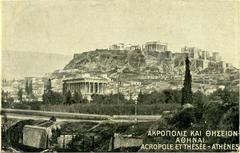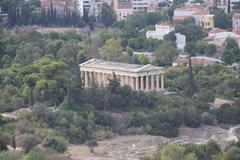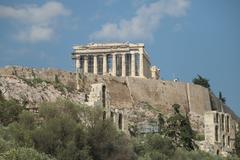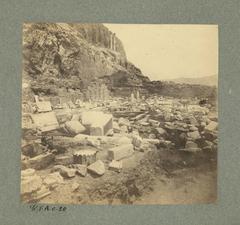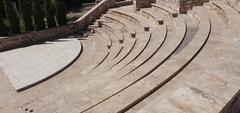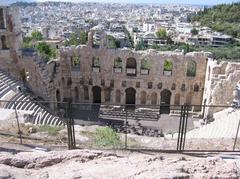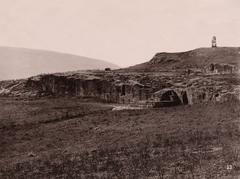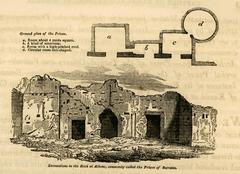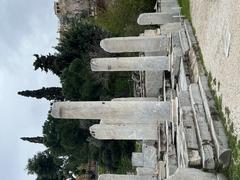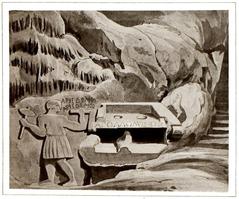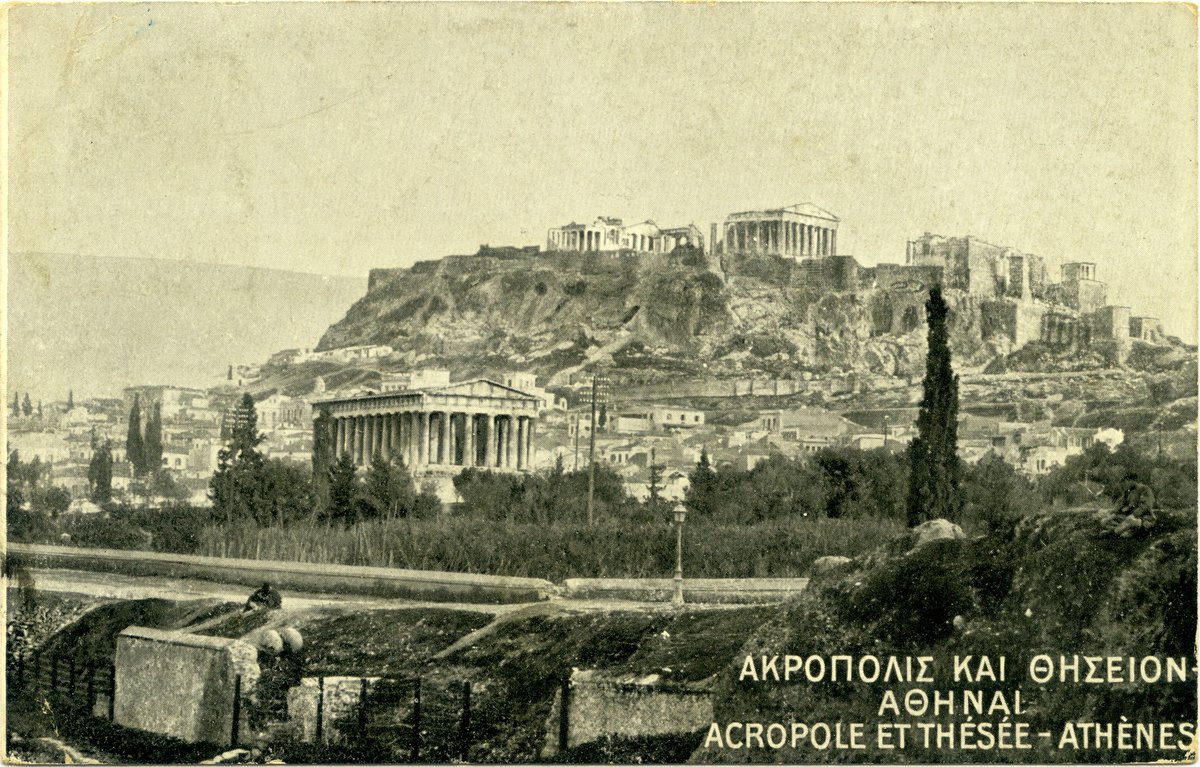
Visiting Hours, Tickets, and Historical Significance of Ναός Ηφαίστου in Piraeus, Greece
Date: 18/07/2024
Introduction
Table of Contents
- Introduction
- Exploring the Temple of Hephaestus
- Historical Context and Cultural Impact
- Practical Visitor Information
- A Window into Ancient Athenian Life
- Enduring Legacy and Cultural Impact
- Preservation and Archaeological Efforts
- Conclusion
- FAQ
Exploring the Temple of Hephaestus
Architectural Significance and Structure
Doric Order and Design Principles
The Temple of Hephaestus is a classic example of the Doric order, the simplest and most austere of the three classical Greek architectural orders. Characterized by its simple, sturdy columns with plain, circular capitals (tops) and fluted shafts, the temple showcases these features beautifully.
The temple follows a peripteral design, meaning it is surrounded by a single row of columns (peristyle). It has six columns on its short sides (hexastyle) and thirteen on its long sides. This specific arrangement of columns was common in Doric temples of this period.
Dimensions and Materials
The Temple of Hephaestus is relatively small compared to other ancient Greek temples, measuring approximately 13.71 meters wide and 31.77 meters long. However, its compact size does not diminish its architectural impact. The temple’s proportions are carefully calculated to create a sense of harmony and balance.
The temple was constructed primarily of Pentelic marble, a high-quality white marble quarried from Mount Pentelicus. This material was prized for its durability and luminosity, giving the temple a gleaming white appearance in its original state.
Interior Layout and Decoration
Like most Greek temples, the Temple of Hephaestus was designed to house a cult statue of the deity to whom it was dedicated. The interior of the temple was divided into two main sections:
- Pronaos (Porch): The pronaos was the entrance to the temple, marked by the first row of columns. It served as a transitional space between the exterior and the inner sanctum.
- Cella (Naos): The cella was the inner chamber of the temple, where the cult statue of Hephaestus was located. This room was accessed through a large door and was originally lit only by a single opening in the roof.
The temple was adorned with intricate sculptures and reliefs, many of which have survived to this day. The most notable sculptural elements include:
- The Friezes: The temple features two friezes, one on the east side depicting scenes from the labors of Heracles and one on the west side depicting scenes from the Trojan War.
- The Pediments: The triangular spaces (pediments) at the front and back of the temple were originally decorated with sculptures, but these have unfortunately been lost over time.
Visiting Information
Visiting Hours
The Temple of Hephaestus is open to visitors throughout the week. The opening hours are as follows:
- Monday to Sunday: 8:00 AM to 7:00 PM
Please note that visiting hours may vary during holidays or special events, so it is recommended to check the official website for the most up-to-date information.
Tickets and Pricing
The entrance fee for the Temple of Hephaestus is as follows:
- Adults: €10
- Students (with valid ID): €5
- Children under 12: Free
Combination tickets that include access to other historical sites in Athens are also available. Visitors are encouraged to purchase tickets in advance to avoid long queues.
Travel Tips and Nearby Attractions
Accessibility
The Temple of Hephaestus is accessible to visitors with mobility issues. Ramps and pathways are available to ensure a comfortable visit for everyone.
Guided Tours
Guided tours are available and highly recommended for those interested in learning more about the history and architecture of the temple. These tours provide valuable insights and enhance the overall visitor experience.
Nearby Attractions
The Temple of Hephaestus is located within the Ancient Agora of Athens, which is home to several other historical sites. Nearby attractions include:
- The Stoa of Attalos
- The Museum of the Ancient Agora
- The Church of the Holy Apostles
A Lasting Legacy
The Temple of Hephaestus stands as a testament to the architectural genius of the ancient Greeks. Its enduring beauty and remarkable state of preservation continue to inspire awe and wonder in visitors from around the world. It serves as a reminder of the enduring legacy of classical architecture and its profound impact on Western civilization.
FAQ
- What are the visiting hours for the Temple of Hephaestus?
- The temple is open from 8:00 AM to 7:00 PM daily.
- How much are tickets to the Temple of Hephaestus?
- Tickets cost €10 for adults, €5 for students, and are free for children under 12.
- Is the Temple of Hephaestus accessible for visitors with mobility issues?
- Yes, the temple has ramps and pathways to ensure accessibility for all visitors.
Conclusion
The Temple of Hephaestus is a must-visit for anyone interested in ancient Greek architecture and history. With its well-preserved structure, rich historical significance, and convenient visitor amenities, it offers a unique and enriching experience. Plan your visit today and explore one of Athens’ most iconic historical sites.
Historical Context and Cultural Impact
Dedication to the God of Craftsmanship
The Temple of Hephaestus, standing proudly atop Agios Georgios Hill in Athens, is a testament to the city’s rich history and enduring cultural heritage. Unlike many temples dedicated to the Olympian gods, this particular edifice honors Hephaestus, the god of fire, craftsmanship, metalworking, and sculpture. This dedication reflects the importance of these crafts in ancient Athenian society, where skilled artisans played a vital role in the city’s economic and cultural prosperity.
A Symbol of Athenian Democracy
The temple’s construction, believed to have begun around 449 BCE, coincided with a period of significant political and social change in Athens. This era, often referred to as the Golden Age of Athens, saw the rise of democracy under the leadership of Pericles. The construction of the Temple of Hephaestus, alongside other ambitious architectural projects like the Parthenon, served as a powerful symbol of Athenian democracy, showcasing the city’s wealth, power, and artistic achievements to the world.
Architectural Significance and Influence
The Temple of Hephaestus is a masterpiece of Doric architecture, renowned for its harmonious proportions and exquisite craftsmanship. Its design, attributed to the architect Iktinos who also worked on the Parthenon, features a traditional peripteral plan with six columns on the short sides and thirteen on the longer sides. The temple’s well-preserved structure, constructed primarily from Pentelic marble, offers valuable insights into ancient Greek architectural techniques and aesthetics. Its influence can be seen in countless buildings throughout history, solidifying its place as a cornerstone of classical architecture.
Transformation and Adaptation Through Time
While initially dedicated to Hephaestus, the temple underwent a transformation in the 7th century AD when it was converted into a Christian church dedicated to Saint George. This adaptation reflects the evolving religious landscape of the region and highlights the building’s ability to adapt to changing cultural contexts. For centuries, the temple served as a place of Christian worship, further enriching its historical tapestry.
Rediscovering a Cultural Treasure
Following the Greek War of Independence in the 19th century, the Temple of Hephaestus underwent a period of rediscovery and restoration. Archaeological excavations unearthed its ancient past, revealing its original dedication to Hephaestus and shedding light on its significance within the ancient Athenian cityscape. Today, the temple stands as a prominent landmark in Athens, attracting visitors from around the globe who come to marvel at its architectural splendor and delve into its captivating history.
Preservation and Archaeological Efforts
The Temple of Hephaestus, standing as a testament to ancient Greek architectural prowess, is not merely a relic of the past but an active participant in the ongoing narrative of Greece’s cultural heritage. Preservation and archaeological efforts are vital to ensure its longevity and to further unravel the mysteries it holds.
Ongoing Conservation Projects
The Ephorate of Antiquities of West Attica, Piraeus, and Islands, a department within the Hellenic Ministry of Culture and Sports, oversees the preservation of the Temple of Hephaestus. They undertake various projects aimed at:
- Structural Consolidation: This involves reinforcing the monument’s structure to withstand the test of time and natural elements. Techniques like anastylosis, the reassembling of fallen fragments, are employed. Recent efforts have focused on strengthening the columns and architraves, ensuring the temple’s stability.
- Stone Preservation: The Pentelic marble, while durable, is susceptible to weathering and environmental pollution. Specialists conduct regular cleaning using gentle methods to remove dirt and pollutants. They also apply protective coatings to shield the marble from further deterioration.
- Drainage System Maintenance: Effective water management is crucial to prevent water damage and erosion. The existing drainage system, designed to channel rainwater away from the temple, undergoes regular cleaning and maintenance.
Archaeological Investigations
While the Temple of Hephaestus has been extensively studied, archaeological investigations continue to reveal new insights into its past:
- Excavations: Archaeologists conduct targeted excavations around the temple to uncover buried structures and artifacts. These excavations help to understand the temple’s construction phases, its use in antiquity, and the surrounding urban landscape. Recent excavations have revealed remnants of workshops and other structures, suggesting a bustling hub of activity around the temple in ancient times.
- Artifact Analysis: Artifacts unearthed during excavations, such as pottery shards, tools, and decorative elements, are meticulously analyzed. These provide valuable information about the daily life of people who lived and worked near the temple, their religious practices, and the trade networks of ancient Athens.
- Epigraphic Studies: Inscriptions found on the temple and surrounding structures offer valuable historical data. Epigraphers study these inscriptions to decipher their meaning, shedding light on the temple’s dedication, religious practices, and even political events of the time.
Challenges and Future Directions
Preserving a monument as significant as the Temple of Hephaestus presents ongoing challenges:
- Environmental Impact: Air pollution, particularly in Athens, poses a significant threat to the Pentelic marble. Acid rain and particulate matter accelerate the weathering process, requiring ongoing conservation efforts.
- Tourism Pressure: The temple’s popularity as a tourist destination, while positive for cultural appreciation, necessitates careful management. Foot traffic and potential vandalism require measures to balance accessibility with preservation.
- Urban Development: As Athens continues to grow, the pressure of urban development encroaches upon archaeological sites. Balancing the needs of a modern city with the preservation of its ancient heritage requires careful planning and collaboration.
Looking towards the future, preservation efforts at the Temple of Hephaestus will likely focus on:
- Sustainable Conservation: Implementing eco-friendly cleaning and preservation techniques to minimize the environmental impact of conservation efforts.
- Digital Documentation: Utilizing 3D scanning and modeling to create a detailed digital record of the temple. This technology aids in monitoring structural changes, planning conservation interventions, and providing virtual access for research and education.
- Public Engagement: Raising public awareness about the importance of cultural heritage preservation through educational programs, guided tours, and interactive exhibits. Engaging the community fosters a sense of ownership and responsibility towards protecting these invaluable sites for future generations.
Conclusion
FAQ
- What are the Temple of Hephaestus visiting hours?
- The temple is open from 8:00 AM to 7:00 PM daily.
- How much are tickets to the Temple of Hephaestus?
- General admission is around €10, with discounts available for students, seniors, and children.
- Is the Temple of Hephaestus accessible?
- Yes, the temple is accessible to visitors with disabilities, with ramps and pathways designed for wheelchairs and mobility aids.
- What nearby attractions should I visit?
- Visitors should explore the Ancient Agora of Athens, the Acropolis, and the Parthenon, which are all in close proximity to the Temple of Hephaestus.
